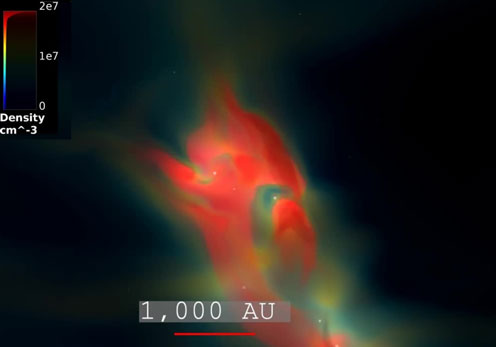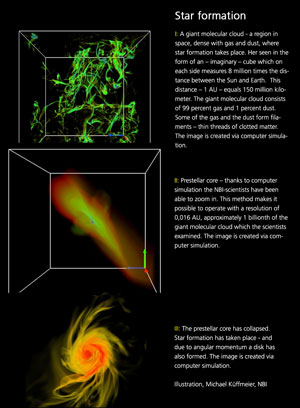Star formation influenced by local environmental conditions
Three scientists at Niels Bohr Institute (NBI), University of Copenhagen, have carried out extensive computer simulations related to star formation. They conclude that the present idealized models are lacking when it comes to describing details in the star formation process. “Hopefully our results can also help shed more light on planet formation”, says Michael Küffmeier, astrophysicist and head of the research team.

Our own galaxy, the Milky Way, consists of more than 100 billion stars. New stars are formed in so-called molecular clouds, where most of the gas is in the form of molecules, and is very cold. In the Milky Way there are many different varieties of molecular clouds, with for example masses ranging from a few hundred to several million times the mass of the Sun. Photo: NASA
In order to explain the basics of star formation, one can use simple models – simple geometrical shapes that are easy to understand and relate to.
But even so – even when such simple models can explain the basic principles at work, they may still be lacking when it comes to quantitative details - which is exactly what three researchers from Centre for Star and Planet Formation at NBI demonstrate in a scientific article just published in The Astrophysical Journal.
The scientists carried out computer simulations of the formation of hundreds of stars, from which nine carefully selected stars, representing various regions in space, were chosen for more detailed modeling, explains astrophysicist Michael Küffmeier, head of the project – which is also a major part of his Ph.D. dissertation.
Küffmeier planned and carried out the research in cooperation with NBI-colleagues professor Åke Nordlund and senior lecturer Troels Haugbølle – and the simulations show that star formation is indeed heavily influenced by local environmental conditions in space, says Küffmeier: “These conditions e.g. control the size of protoplanetary disks, and the speed at which star formations takes place – and no scientific study has ever shown this before”.
Computers working around the clock
According to the classical model, a star is formed when a prestellar core – a roundish accumulation containing approximately 99 percent gas and 1 percent dust – collapses due to ‘overweight’. Subsequently, a star is formed in the center of the collapse – followed, as a result of angular momentum, by the formation of a disk of gas and dust rotating around the star..
Click on image to read about the Star formation.
“This is the star’s protoplanetary disk, and planets are thought to be formed in such disks – planet Earth being no exception”, says Michael Küffmeier.
But how did the NBI-researchers manage to detail this model? The answer is closely linked to state-of-the-art computer simulations: You feed some of the most potent computers available with an almost unfathomable ‘load’ of information - and let them grind around the clock for months. And then, Michael Küffmeier says, you may be lucky enough to be able to put to the test even established concepts:
“We started by studying the step before the prestellar cores. And when you have a go at that via computer simulations, you will inevitably have to deal with Giant Molecular Clouds – which are regions in space dense with gas and dust; regions, where star formation takes place”.
A very voluminous cloud
A giant molecular cloud is called ‘giant’ for a reason – just take the giant molecular cloud which the three NBI-researchers studied. If you look closely at this cloud – and for computational reasons decide to examine it by ‘squeezing’ it into a cubical model, which is what the researchers did – you end up with a cube measuring 8 million times the distance between the Sun and Earth on all sides. And if you carry out that multiplication, the end result will be more figures than most brains can even vaguely comprehend, since the distance from the Sun to Earth is 150 million kilometer.
The NBI-researchers looked closely at nine different stars in this giant molecular cloud – “and in each case we gathered new knowledge about the formation of this particular star”, says Michael Küffmeier:
Star formation in a giant molecular cloud. The small white dots represent stars in the computer simulation.

Star formation in a giant molecular sky. All the small white dots represent a star in the computer simulation.
“Since we worked in different regions of a giant molecular cloud, the results from the stars examined revealed differences in e.g. disk formation and disk size which can be attributed to the influence exerted by local environmental conditions. In this sense we have gone beyond the classical understanding of star formation”.
The NBI-team had access to super computers – a large number of single computers linked in networks – some in Paris, and some in Copenhagen at the H.C. Ørsted Institute at University of Copenhagen. And the machines were really put to work, says senior lecturer Troels Haugbølle, one of Michael Küffmeiers co-authors:
“These calculations were so extensive that if you imagine that the simulations describing the formation of just one of the stars were to be carried out on a single lap top-computer, the machine would have to work 24/7 for the better part of 200 years”.
Supported by observations
Based on the computer simulations, the three NBI-scientists have studied in particular the influence of magnetic fields and turbulence – factors that are seen to play important roles in star formation. This may, adds Michael Küffmeier, be one of the reasons why protoplanetary disks are relatively small in some regions of a giant molecular cloud:
“We are able to see how important the environment is for the star formation process. We have thus started on the path to make realistic, quantitative models of the formation of stars and planet, and we will continue digging deeper into this. One of the things we would like examine has to do with the fate of dust in protoplanetary disks – we want to know how dust and gas are separated, allowing in the end planets to form”.
The NBI-scientists are pleased that their computer simulations seem to be supported by telescope observations, from space and from the ground – among these, observations carried out by the powerful ALMA-telescope in Northern Chile, says Michael Küffmeier: “These are observations which qualitatively corroborate our simulations”.
The fact that the telescope observations “qualitatively corroborate” the NBI computer simulations means that the two sets of data do not in any significant way collide or contradict each other, explains Michael Küffmeier: “Nothing derived from the telescope observations contradicts our main hypothesis: that star formation is a direct consequence of processes happening on larger scales”.

ALMA (Atacama Large Millimeter / Submillimeter Array) in Chile can in the future eventually contribute to an expanded understanding of planetary formation. Photo: ESA
The scientists expect that their continued computer simulations will contribute to a better understanding of planet formation – by combining knowledge gleaned from the NBI-simulations with observations carried out by ALMA as well as the extremely advanced James Webb Space Telescope scheduled for launch in October 2018.
“The James Webb Space Telescope will be able to provide us with information regarding the atmosphere surrounding exoplanets – planets outside our solar system orbiting a star”, says Michael Küffmeier: “This, too, will help us get a better understanding of the origin of planets”.
- Read the scientific publication here:
- The publication >>
 Michael Küffmeier, PhD student and Research assistant, Astrophysics and Planetary Science, Niels Bohr Institute, University of Copenhagen, Email: kueffmeier@nbi.ku.dk
Michael Küffmeier, PhD student and Research assistant, Astrophysics and Planetary Science, Niels Bohr Institute, University of Copenhagen, Email: kueffmeier@nbi.ku.dk
Troels Haugbølle, Associate professor, Astrophysics and Planetary Science, Niels Bohr Institute, University of Copenhagen, Email: troels.haugboelle@snm.ku.dk Phone: +45 35 32 11 41 Mobil: +45 29 38 25 88
Åke Nordlund, Professor, Astrophysics and Planetary Science, Niels Bohr Institute, University of Copenhagen, Email: aake@nbi.ku.dk Phone: +45 35 32 59 68 Mobil: +45 53 62 13 25
Topics
See also:
Video: Computer simulation
The video shows the development of the disc over 1000 years, starting around 50,000 years after the star formation.

